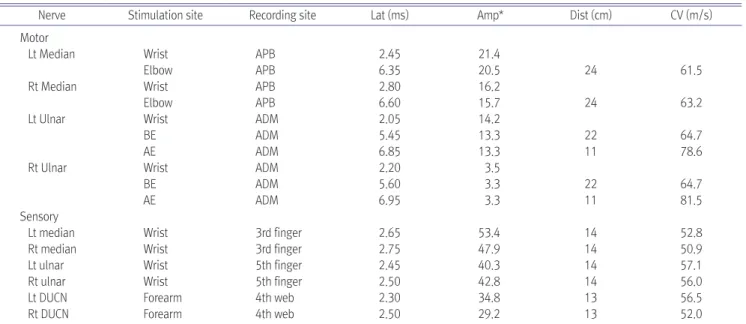Introduction
Ulnar neuropathy at the wrist (UNW) is uncommon and Guyon’s canal is a region where the ulnar nerve is vulnerable to compression. Ulnar nerve compression within Guyon’s canal may produce various clinical
symptoms, including motor and (or) sensory abnor
malities. However, isolated compression of the deep branch of the ulnar nerve is rare.
1,2The etiology of the UNW includes tumors, fracture, or dislocations of the carpal bones, anatomical variations, or overuse injuries.
2,3A ganglion has been known to a rare cause of UNW as well.
Ganglions are the most common soft tissue tumor of the hand and wrist, but their etiology and formation remain obscure.
4,5Several studies have described intracarpal ligament lesions as the underlying cause of pain in wrist ganglions.
6,7However, there is little known about the relationship between triangular
삼각섬유연골 복합체 병변과 연관된 결절종에 의한 손목부위 척골신경병증 - 증례 보고 -
이현일
1
, 구정회2
, 송선홍2
1인제대학교 의과대학 일산백병원 정형외과학교실, 2울산대학교 의과대학 강릉아산병원 재활의학교실
Ulnar Nerve Deep Branch Compression at the Wrist by a Ganglion and an Associated Triangular Fibrocartilage Complex Lesion - Case Report-
Hyun Il Lee
1, Jung Hoi Koo
2, Sun Hong Song
21
Department of Orthopedic Surgery, Ilsan Paik Hospital, Inje University College of Medicine, Goyang,
2
Department of Rehabilitation Medicine, Gangneung Asan Hospital, University of Ulsan College of Medicine, Gangneung, Korea
Received February 9, 2017
Revised (1st) March 8, 2017, (2nd) April 20, 2017 Accepted April 21, 2017
Corresponding Author: Jung Hoi Koo
Department of Rehabilitation Medicine, Gangneung Asan Hospital, University of Ulsan College of Medicine, 38 Bangdong-gil, Gangneung 25440, Korea
Tel: 82-33-610-4951, Fax: 82-33-610-4960, E-mail: mdjhkoo@naver.com
Ulnar neuropathy at the wrist (UNW) is uncommon and it may result from various causes such as tumors, fracture, or overuse injuries. Also a ganglion has been reported as a rare cause of UNW. Ganglions are the most common soft tissue tumors of the hand and wrist, but their etiology remains controversial. Several studies have described associated abnormalities of the intracarpal ligaments. However, ganglions associated with triangular fibrocartilage complex (TFCC) lesions are rarely reported so far. We hereby report a case of UNW caused by a ganglion and an associated TFCC lesion.
Key Words: ulnar neuropathy, ganglions, triangular fibrocartilage complex
Copyright © by Korean Association of EMG Electrodiagnostic Medicine
This is an Open Ac cess article distributed under the terms of the Creative Commons Attribution Non-Commercial License (http://creativecommons.org/licenses/by-nc/4.0) which permits unrestricted non-commercial use, distribution, and reproduction in any medium, provided the original work is properly cited.

